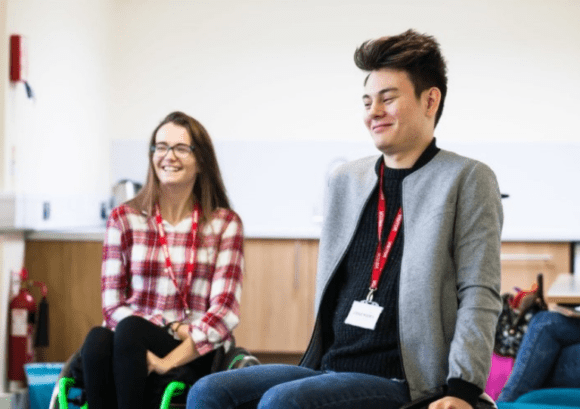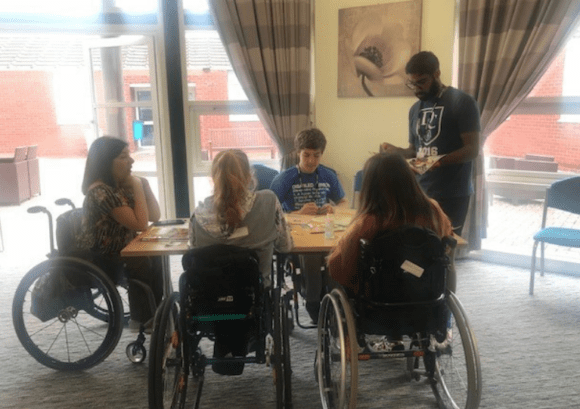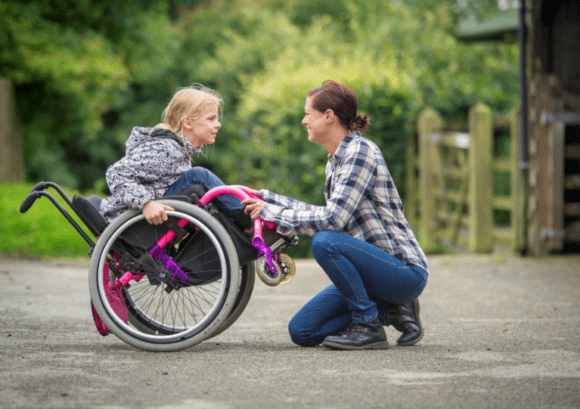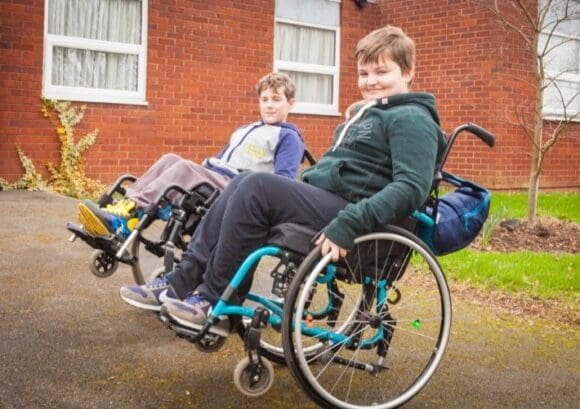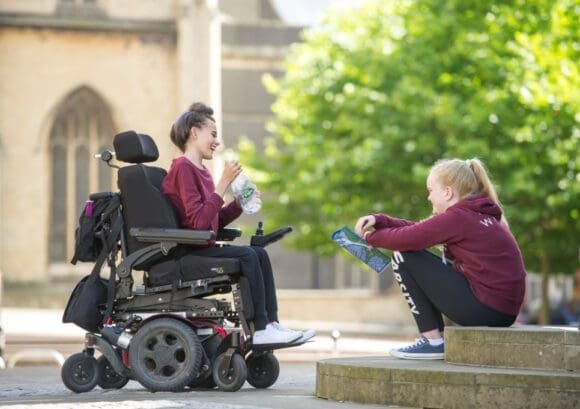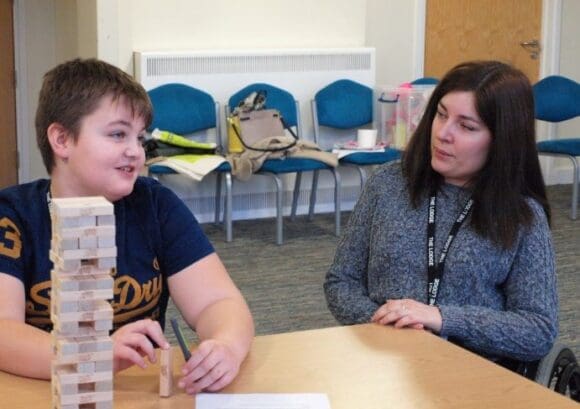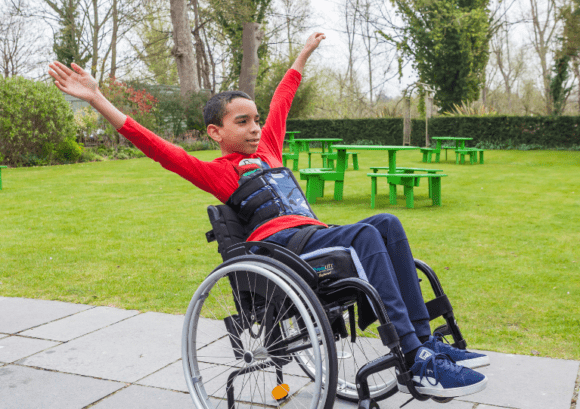Preparing to welcome a student with a spinal cord injury
Returning to Education after Injury
It may seem daunting for a school or education provider to consider how to include a child or young person with a spinal cord injury. However it is important to remember that with the right support, many children and young people with spinal cord injury do have a positive education experience, other schools have done it and there are support networks, information and many resources available that can help.
Knowing what to expect
Remember that every child and young person with a spinal cord injury is unique and will have individual specific requirements and needs. Involving the child or young person, their family and the health teams working with them from the outset will help make sure you understand and learn how to meet these individual requirements. While many of the requirements will be related to the physical and medical impact of having a spinal cord injury, schools also need to consider the impact on the student’s academic and social life as well as emotional mental health and wellbeing.
If the process feels difficult or daunting, contact the local authority to find out what support is offered. Most local authorities will have Advisory Support Teachers, who help schools prepare for and include students with various specific needs – including making adaptations, using assistive technology, training staff, using Teaching Assistants, and ensuring inclusive policies and practices. Additionally, your school will have put other inclusion policies or practices in place and these can often be transferred or adapted
Learning about the child or young person’s specific requirements
” My school was really good. They were eager to get me back. The teachers were understanding about everything, for example if I wasn’t well or couldn’t go in or if I had a hospital or doctor’s appointment. They understood that it was not going to be the same as before. They gave me extra time to do things. My advice to schools would be don’t act differently because the young person is in a chair because they are exactly the same person, apart from going from walking to sitting. That was what I didn’t like – the teachers were constantly asking if I was OK.”
Danielle, 17
One of the most important things to do is to collect accurate and useful information about what the child needs in order to be included in school. This could involve:
– The child or young person’s specific medical requirements and subsequent implications on their life at school (e.g. mobility, bowel and bladder management)
– Any medical issues that may arise at school or what ongoing medical treatment schools may need to accommodate (e.g. physiotherapy)
– Any changes to the way the child communicates or learns (e.g. if they become primarily an auditory learner)
– Considerations on how the child can be re-integrated socially into the school community
– Transport requirements
– What equipment or technology the child or young person may need
– Guidance on providing any necessary mental health support
Remember that the child may have or may be experiencing Post-Traumatic Stress and that families and siblings will often also be going through a difficult time.
“In a school setting, it is very important for teachers to understand the needs and abilities of individual students with spinal cord injuries, and not to assume that all spinal cord injuries will be the same, or that students will have the same sensation and movement control. It is helpful to learn about individual students and ask what support and assistance they need. It is also important to be sensitive to issues such as bladder and bowel management and the need for assistance with activities”
Dr. Angela Gall, Consultant London Spinal Cord Injury Centre, Stanmore
This information can begin to be gathered from the child’s health team at the spinal cord injury centre or general hospital. Schools should have contact with a spinal cord injury centre or a general hospital while the student is in hospital. Before discharge, most spinal cord injury centres and hospitals will contact the school and arrange meetings to discuss the child or young person’s requirements – including access, medical, emotional and learning needs. Often, an occupational therapist will visit the school – sometimes with the student – to discuss necessary physical adaptations or required equipment.
Schools should also be invited to the child or young person’s ‘Discharge Planning Meeting’ when they are discharged from hospital, during which a report will be given on the medical issues. Additionally, health professionals such as a case manager or liaison nurse will go to schools and provide health education to whoever will be the responsible person at school – possibly a school nurse, SENCO or the head teacher. Depending on the child’s requirements, other health care professionals such as a community physiotherapist may also become involved in the school.
How a school uses the information about a child’s specific requirements depends on the situation. There should be a structure and procedure for providing and reviewing support such as an Education Health Care Plan. An Education Health Care Plan should be developed with the child and family alongside education and health professionals. This plan will detail how to meet the child or young person’s academic, social, personal, medical and emotional needs. You can find out more about Education Health Care Plan’s in the ‘Frequently Asked Questions’ section of this toolkit.
“Schools can promote inclusion by getting good advice from spinal centres and hospitals about access and the management of the spinal cord injury. Questions such as “Is this the right place for them?” “What if there is a medical concern during the school day?” “How can we fit in standing regimes?” need to be considered in context, with accurate and up-to-date information.”
Zoe Chevalier, Clinical Psychologist, Stoke Mandeville
Returning to school after facing any trauma can be difficult. For children and young people who have experienced a spinal cord injury, re-integrating can be particularly difficult. They will likely be dealing with significant physical, emotional, and familial changes outside the school.
Facing their peers and their previous educational experience as a non-disabled student can be extremely challenging. A positive, warm, sensitive and hopeful welcome can make a huge difference to how successfully that child or young person re-enters the school community.
“When I went back to school I was nervous because I didn’t know how people would react to me being in a wheelchair. It was bad because of the anxiety, and the depression I got. It was just so bad, I found it really hard even getting in the car let alone going into the school itself. But the school was really supportive. They never forced me to do anything; they let me take it at my own pace.”
Ben, 17
Children and young people with spinal cord injuries have said they cope much better with returning school if they are properly prepared.
“Make sure everything’s in place before the young person returns, and make sure the school fully understands about having a student there with a spinal cord injury.”
Ben, 17
Proper preparation and support of young people before returning has also been connected with students being able to attend school full-time immediately rather that a gradual part-time entry.
Preparations they identified as being useful included:
1. Visiting the school before returning – possibly with a parent or an occupational therapist. The visits re-establish relationships with staff and students and allow the student to practice moving around the school and using new equipment as required.
2. Attending a meeting at the school with professionals and their parents – Meetings could involve hospital-based professionals, parents, school staff and the child/young person. The meeting could cover the child’s requirements, school responses to those requirements and an assessment of the physical environment. Importantly, these meetings should involve the child and consider their ideas and perspectives on their needs and how to address them.
3. Remember children and young people who have a spinal cord injury may be reluctant to return to school or engage with anything that reminds them of their disability. Offering emotional or psychological support, as well as being sensitive to their situation, are some strategies to address this.
“Ask the person in the wheelchair what they want to do and what they think about things instead of asking the parents all the time”
Julie, 18
A 2008 study by the Institute of Education explored the school lives of children and young people with a spinal cord injury. Most students in the study obtained their injury in childhood or adolescence, meaning they had to return to the school they had previously attended. For many, ‘this was a difficult and sometimes traumatic event.’ One student in the study returned to school just before his GCSE’s and felt ‘uncomfortable’, ‘out of place’ and like ‘everyone was watching him’.
– Many found the return to school full of mixed emotions. While it was good to see friends again, ‘at the same time it was a difficult transition’
– Students felt different and reported seeing their classmates as different too
– They reported feeling nervous about how to handle their bodies
– Students also reported that they did not want to be treated differently just because they had been spinally injured. However, some felt that attitudes towards them had changed.
“It was a bit weird. A lot of the class, I didn’t even recognise them. Their personalities had changed and they were different” Tim, 10
“It was really good at first, although I was a bit shaken and a bit nervous at first about going in; I hadn’t yet got used to how to handle my body and that” Ian, 16
“Strange and then happy. At first they treated me a bit differently but I said to them just treat me as normal. They kept asking ‘do you need this, do you need that?’ but I said, ‘no, I can do it myself’.” Janine, 17
“I remember the dinner lady – before she was always having a go at me and then when I came back in a wheelchair she was all sorry for me, which I don’t want, some people are like that…..I don’t want to be treated differently from other people.” Ali, 15
Strategies that can help welcoming the student back to school
1. Visits from teachers or friends can make it easier to cope with returning to school. You can find information about this elsewhere in the toolkit.
2. Discuss with the child or young person what kind of welcome they would like, if any. Some may want a formal assembly where they (or someone they choose) can provide information about what happened to them and what adjustments need to be made for them. Others may prefer the school community is informed but just want a small Q&A session with friends to discuss what happened. Some may not want any recognition of their experience. The most important thing is that they are comfortable and involved at how they are welcomed back to school.
3. Consider a buddy system and pair up the child or young person with a friend or another student of their choice who can accompany them back to school on the first day and who understands the issues and what adjustments they need.
4. Ensure all school staff are aware of the return of the student and how to welcome them sensitively and in a non-patronising way. It is also important that all staff are trained in recognising relevant medical issues, such as autonomic dysreflexia. For more information on this, see section c)
5. Promote and display positive role models and ideas of disability within the school. Make sure this is done in a sensitive way that illustrates the successful, varied, fulfilling and ordinary lives that disabled people have.*
Resources to link to or include:
*Taken from: Knight, A, Petrie, P, Potts, P and Zuurmond, M. (2008) The school lives of children and young people with a spinal cord injury. Thomas Coram Research Unit, Institute of Education, University of London. Report for Back Up
Preparing the school community
Preparing all those in the school community about having a student with a spinal cord injury is vital. This section gives ideas and strategies on how to do this by covering:
– Whole school
– Before yours student returns to school
– Staff
– Students and peers
– Preparing the child or young person
– Resources
Preparing all those in the school community – staff, students, the child or young person with a spinal cord injury and their families – is vital. The child and family’s life has changed profoundly and the school community will need to adjust to welcome them with sensitivity and warmth. How this is done depends on the school, its culture and, most importantly, the involvement of the child and their family.
Back Up understands that a spinal cord injury can be devastating, but we believe it should not prevent anyone from getting the most out of life.
Research and those in the field supports this point of view:
“At Stoke Mandeville, we have a strong research and clinical background, and from that are able to say that most people adjust and cope really well in the long term and do go on to do really well and get back to school and education and create relationships. This is a really important message to get across. It’s not the norm that people with spinal cord injury have long-term psychological trauma and difficulty. It’s more normal to cope and make adjustments.”
Zoe Chevalier, Clinical Psychologist, Stoke Mandeville SCI Unit
When preparing the school community for welcoming a child or young person with a spinal cord injury, a realistic recognition of the changes they’ve undergone should be balanced with a message of positivity and examples of others who have coped in similar situations. This must, of course, be handled sensitively as the child or young person may not be immediately ready to openly discuss these issues but a message of hope and optimism is an important one for the community to have at its heart.
Whole school
Developing an inclusive school culture at a whole-school level is vitally important – not only for the child or young person with a spinal cord injury but for all students in the community. The expectation should be that the student will be included in all aspects of school life. The question is how to make that happen. School culture and attitudes are paramount at seeing this expectation made real.
“If the whole school ethos is about meeting emotional and social needs then it doesn’t matter so much about where your legs are.”
Head Teacher, Primary School*
Top tips for schools
1. Ensure that the student is involved and consents to how their situation is described and discussed with staff and other students. Any preparatory work with staff and students should be communicated to the child or young person so they are aware of what the school community has been told before they go back to school.
2. Linking with schools which have already gone through a process of inclusion can be really vital. Back Up’s schools and family inclusion service can facilitate this link.
3. Link in with school/authority based inclusion personnel to feed into already established strategies and processes, is key, for maximum impact. Advisory support teachers are good places to start.
4. Include issues of diversity, equality and inclusion into the curriculum, school events and displays. Promoting positive images of disability and diversity within the school.
5. Involve an adult with a spinal cord injury, preferably at a similar injury level to the young person being included. Back Up can arrange for a spinal cord injured Education Advocate to visit the young person and the school. We can also provide peer mentoring for longer term support.
6. Access disability equality training and support – for teachers, support staff and all people who work in schools.
Staff
“ My advice is to talk to the student, don’t feel bad or embarrassed or shy about talking to them about their spinal cord injury. This might seem like a little thing but it can make a huge difference to the student. Asking them what they want is so important.
Ben, 17
Depending on when they were originally trained and their previous experience, teachers and staff may have a huge variation in knowledge and skills related to inclusion of children with different requirements.
Staff may need training and information around the health requirements of children and young people with SCI who are returning to school.
Liaising with health care professionals to provide training on specific issues (e.g. tracheotomy use) may help staff feel more confident and know what to expect.
Training that may be useful or appropriate for staff include:
– Disability equality
– Wheelchair training so staff know what is safe and unsafe
– Manual handling
– Possible medical issues that arise
– working with PA’s
– Adapting curriculum and teaching strategies
While children and young people with spinal cord injuries are not necessarily any more prone to medical emergencies than their peers, there are some related medical issues that all school staff should know about.
Students and peers
Recognise the importance of friendships and social acceptance in the child’s inclusion into school. Other children and young people with spinal cord injuries have reported how having close friends or support to re-establish friendships aided them in returning to school.
“I was really shy to talk to everyone….but people encouraged me to make friends”
David, 13*
Advice
1. How you prepare other students at the school may depend on a number of factors and should be done in collaboration with the child or young person returning to school and their family. Some may prefer to have a full school assembly while others may wish to meet with a small group of friends or work with small groups.
2. Talking sensitively to the friends or year groups of the returning pupil can help prepare students for what to expect and avoid awkward situations.
3. Other organisations can help plan and facilitate a student’s return to school. Contact Back Up’s Education Inclusion service on 020 8875 1805 or the medical team at the spinal injury centre, to find out how they can help.
Resources
– Blueprint guide ‘Going Back to School: Supporting Young People Returning to School with Spinal Cord Injury: A Guide for Schools‘
*Taken from: Knight, A, Petrie, P, Potts, P and Zuurmond, M. (2008) The school lives of children and young people with a spinal cord injury. Thomas Coram Research Unit, Institute of Education, University of London. Report to the Back-Up Trust.
GO BACKContact
If you’d like learn more about how we can support children and young people with a spinal cord injury, register your interest here and the team will get back to you shortly or give them a call on 020 8875 1805.


